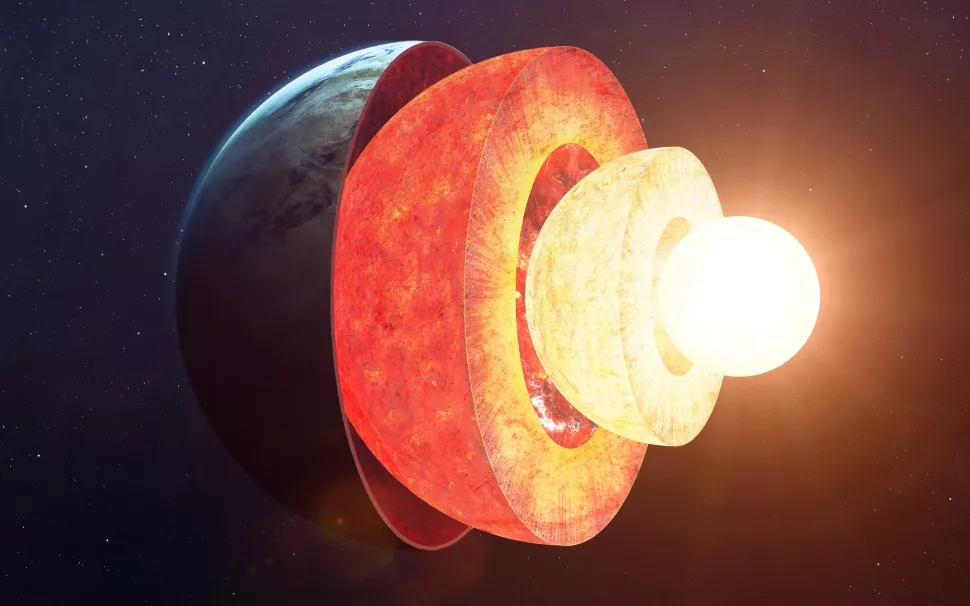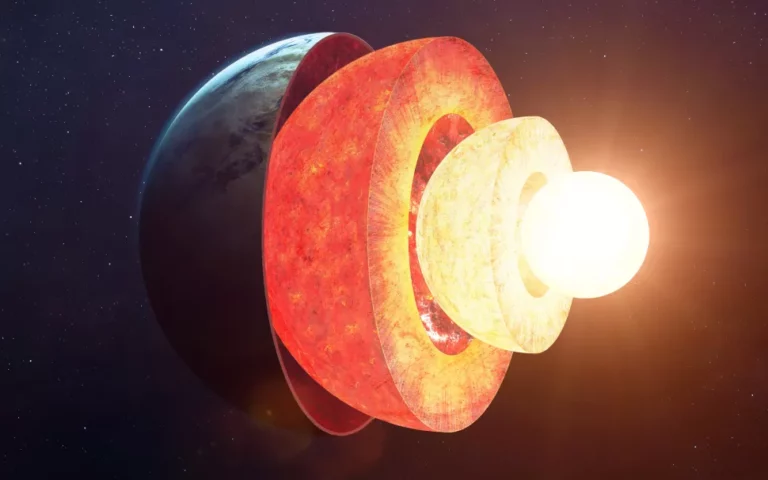The enigmatic center of the Earth is a metallic sphere spanning 400 miles in diameter.
Scientists are shedding new light on Earth’s elusive fifth layer.
Apart from the thin outermost layer that we inhabit, the composition of Earth’s structure below our feet is not easily comprehensible. To simplify the concept, food analogies are often used to explain the four primary layers: crust is compared to graham crackers, mantle to ice cream, outer core to melted marshmallows, and inner core to chocolate chips. Scientists have acknowledged the existence of a fifth layer, referred to as the innermost inner core, which is a metallic sphere with a diameter of 400 miles (650 kilometers) located within the inner core. Although it was initially hypothesized in 2002, its presence has been verified multiple times, most recently in March 2022.

However, owing to its hidden position beneath Earth’s layers and its location within the planet’s inner core, which accounts for less than 1% of Earth’s volume, the innermost inner core remains inadequately understood.
By analyzing seismic waves produced by significant earthquakes, scientists have detected waves reverberating back and forth along Earth’s diameter five times, breaking the previous record of two reflections. These waves are generated when Earth’s tectonic plates experience sudden movement during an earthquake. Observing how these waves become distorted as they travel through Earth’s center is enabling scientists to gain a better understanding of the elusive innermost core. The team of researchers involved in this latest study utilized three separate earthquake datasets to explore Earth’s center in a unique manner, with each event providing a distinct perspective on the core, according to study co-author Hrvoje Tkalčić, who communicated via email to Space.com. One of the seismic events analyzed by the team was the 7.9-magnitude earthquake that occurred in the Solomon Islands in 2017.
“Earth oscillates like a bell after a large earthquake, and not just for hours, but days,” Hrvoje Tkalčić, a geophysicist at the Australian National University and co-author of the latest study, said in a statement .
For scientists to conduct thorough investigations of the innermost core, they require seismometers positioned at the antipodes, which are the points opposite to earthquakes and are frequently located in oceanic regions. However, due to the substantial expenses involved in setting up seismic stations in remote areas, there is limited data available for their studies.
“The innermost inner core is notoriously difficult to probe by seismic waves,” Tkalčić Said
To gain insights into the Earth’s deep interior, the team of researchers combined seismic data obtained from various global data centers concerning a significant earthquake in the Solomon Islands, and studied a type of seismic wave known as the primary, pressure, or P wave. The P wave is the swiftest seismic wave and is the only one capable of traveling through Earth’s center. Therefore, investigating the P wave as it crossed Earth’s center five times enabled researchers to shed light on the planet’s innermost core.
The team led by Tkalčić observed that the wave required 20 minutes to traverse the planet’s width. During each crossing, they noticed the innermost core’s “anisotropic” property. Seismic waves passing through the innermost inner core decelerated in one direction while those moving through the outer layer slowed down in a different direction.
Tkalčić stated in the same statement that “it simply means that the iron crystals — iron, which is dominant in the inner core — are probably organized in a different way than in the outer shell of the inner core.” Since 2003, scientists have been aware that the innermost inner core is anisotropic, and the latest study enhances that understanding with more precise evidence. In this recent research, the team discovered that the direction of P waves within the innermost core is slowest at an “oblique” angle of 50 degrees from Earth’s rotation axis, relative to the equatorial plane.
“This is critical, and this is why we can say we’ve detected ‘distinct’ anisotropy in the innermost inner core,” the authors wrote in a piece published by The Conversation .
There is compelling evidence that the sluggish movement of iron in the core of Earth generates the planet’s geodynamo, leading to the formation of the Earth’s magnetic field. As a result, understanding what occurs at the planet’s core will help elucidate the behavior of the magnetic field, including times when it undergoes reversals.
While the most recent study contributes to the increasing collection of evidence that affirms the innermost inner core as Earth’s fifth layer, it may be some time before educational materials are updated, according to Tkalčić.
“As it was, when the idea of the inner core was first proposed in 1936,” Tkalčić explained, “it took some time for the Earth model to become established and for textbooks to be revised.”
Once Earth’s innermost inner core makes its way into textbooks, food metaphors may emerge, such as a dark chocolate center within a chocolate chip.
Do not forget to share your opinion with us to provide you with the best posts !




You are so interesting! I don’t think I have read through anything like this before.
So wonderful to find another person with a few original thoughts on this subject matter.
Seriously.. many thanks for starting this up. This web site is something that is required
on the web, someone with a bit of originality!